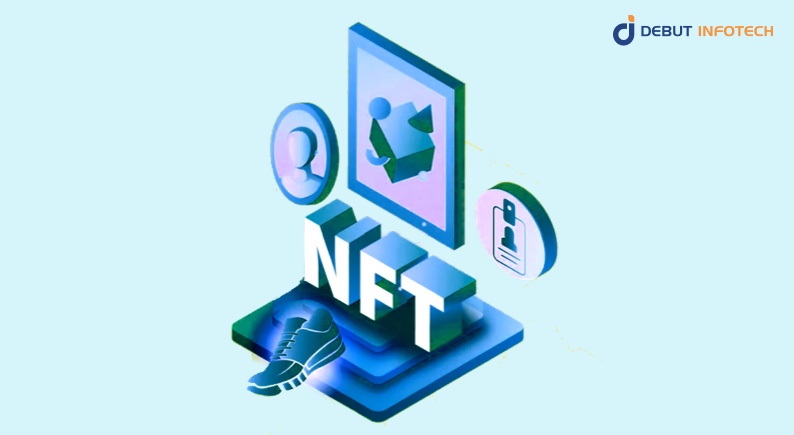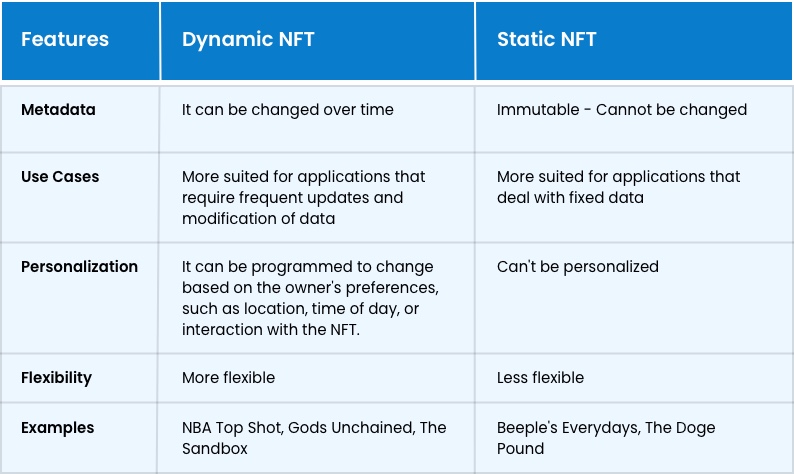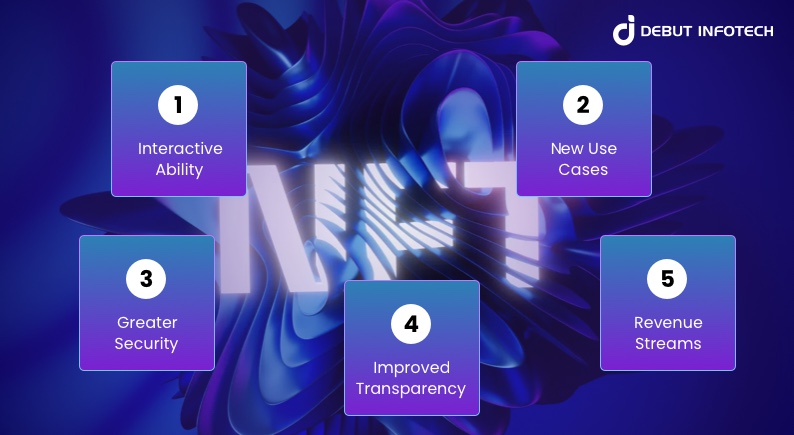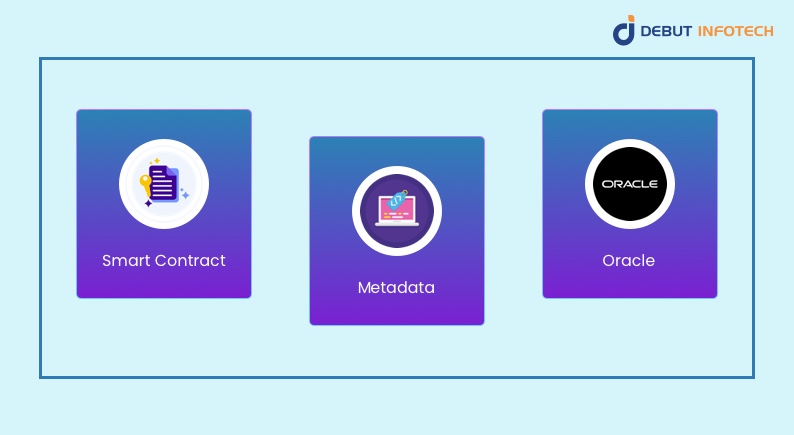Table of Contents
Home / Blog / NFT Marketplace
What are Dynamic NFTs (dNFTs)? A Complete Guide
March 7, 2024

March 7, 2024
Non-fungible tokens (NFTs) are developing at an alarming rate in 2024, with an increase in the number of active users. Static and traditional NFTs have been most popular in the NFT marketplace development. However, Dynamic NFTs (dNFTs) are dominating over their static and traditional counterparts. The reason behind this is the many possibilities and opportunities that dNFTs embody.
The designing space is continuously evolving with dNFTs. But why are Dynamic NFTs becoming more popular? That is because they possess the ability to adapt and grow. NFTs are pieces of art, having only one original copy that stands the test of time. While that makes each Token unique, it cannot become something more profound. dNFTs, on the other hand, can change with respect to the updated data they receive by assessing external events.
In addition, there are many reasons why dNFTs are much more flexible, mutable, and better than regular NFTs. Different organizations and artists can create dNFTs to speed up the NFT marketplace development further and escalate the minting process. If you are an artist or someone new to NFTs, our complete guide about dNFTs will answer all your questions in order.
What are Dynamic NFTs (dNFTs)?
Dynamic Non-Fungible Tokens, or dNFTs, represent the next generation of non-fungible tokens. They offer unique digital tokens that adapt and change according to external conditions such as market prices, weather, and time conditions – recorded within their metadata. They’re designed to respond quickly to various stimuli, including behavior such as behaviors associated with market prices or weather & time events and many other external factors that affect them.

Dynamic NFTs enable the development of evolving digital assets. All of this is only possible due to their interactive and programmable characteristics. Therefore, artists are allowed to create and provide an overall better experience for their fans, collectors, and buyers with the help of lifts. This is how dNFTs are influencing the NFT marketplace development.
The Dynamics NFTs changes are because of changes in the metadata triggered by Smart Contract technology. Automatic changes are encoded in NFT smart contracts. This provides relative info to the respective NFT about when and how its metadata will change.
In summary, Dynamic NFTs are giving the world:
- Personalized Experience: dNFTs can be programmed to change as the owner desires, providing them with a unique experience based on their interaction, times, and even seasonal changes.
- Art that Evolves: dNFTs are pieces of art that can be programmed to change and evolve as time goes on. This enables the art to develop and become even more dynamic and exciting based on its interactions with the owner.
- Interactive Gaming Experience: dNFTs can also be utilized to develop interactive games, where NFTs can undergo upgrades, and a platform where players can compete as well, creating a new possibility for Blockchain gaming.
Dynamic NFT Examples
Let’s take a look at some Dynamic NFT examples:
CryptoKitties: One of the oldest dNFTs to ever jump in the Ethereum market. It featured virtual cats that could breed and result in offspring with inherited traits. At its peak, its craze congested the Ethereum market.
Spells of Genesis: It is the first ever blockchain-based card game with an economy that the players own. The game featured card-based dNFTs that adapt and gain new abilities based on player interactions and events in the community.
Adidas Originals: Known for its forays into a new era, Adidas has entered the NFT space with dynamic offerings that might consist of exceptional content for NFT holders.
The Living Tree: This single, particular NFT depicts a tree that evolves based on actual-time environmental facts, including temperature, humidity, and pollution ranges. The tree’s health and appearance alternate depending on those elements.
Dynamic NFT and Static NFT: What’s the Difference?
Static NFTs are exceedingly common, but Dynamic NFTs aren’t that far behind either. Here’s a table that covers the key differences between dNFts and Static NFts:

What are the Benefits of Dynamic NFTs?
Dynamic NFTs have numerous benefits over traditional NFTs. They provide more significant interaction, engagement, and security and can be used to curate more use cases that dive into high-end applications.

1. Interactive Ability
Static NFTs are digital representations of ‘Fixed Assets.’ Put simply, they can’t change once they have been made. On the other hand, Dynamic NFTs can respond to user input. They can change their appearances and behavior as the user interacts with them.
2. New Use Cases
Dynamic NFTs give surplus opportunities in various fields for newer use cases. For instance, such tickets can be developed that update according to the event’s proceedings. They can also be incorporated in the form of in-game items that evolve uniquely based on the player’s progression.
3. Greater Security
Dynamic NFTs can be programmed to have specific security measures to keep them safe from theft and hacking. For example, they can be programmed to include a particular identifier. This identifier will change its form each time the dNFT transfers
4. Improved Transparency
The ownership status and provenance of Dynamic NFTs can be tracked by programming them. This helps to provide greater transparency, along with the possibility to identify counterfeit NFTs quickly.
5. Revenue Streams
Dynamic NFTs provide new revenue streams. They will enable creators and artists to earn royalties by either interacting with the NFTs or using them for extended periods.
How Dynamic NFTs Work?

Dynamic NFTs work over three essential components. These are:
- Smart Contract: It is the center of a dynamic NFT. It contains the regulations for how the NFT can exchange, and it is liable for making adjustments to the NFT’s metadata.
- Metadata: The metadata of a dynamic NFT is what defines the NFT’s properties. It can include matters just like the NFT’s name, description, appearance, as well as its current condition.
- Oracle: Oracle is a third-party service that provides external data to the smart contract. This data can be used to trigger changes to the NFT’s metadata, such as when the price of a real-world asset embraces change, etc.
Here’s the step-by-step guide on how Dynamic NFTs work:
- A dynamic NFT is created using a smart contract that consists of a set of guidelines for the way the NFT can trade. These policies may be primarily based on a selection of factors, along with the owner’s options, the time of day, or the overall performance of a real-international asset.
- The smart contract is then deployed to the blockchain, and the dynamic NFT is minted.
- Dynamic NFTs can similarly be purchased, offered, and traded, just like some other NFTs.
- When the NFT adjusts, the smart contract is precipitated, and the modifications are made to the NFT’s metadata.
- The changes to the NFT’s metadata are then reflected on the Blockchain.
How to Create Dynamic NFT?
There are various approaches for creating dynamic non-fungible tokens (dNFTs). You could utilize either a Smart Contract or Decentralized Oracle as a way of making this type of dNFT. However, what exactly are their differences? Let’s discuss:

Smart Contract to Make a dNFT
Smart contracts allow the metadata for an NFT to change automatically according to specific programs; for instance, its changes could depend on current Bitcoin prices or how often its song is played on Spotify.
Decentralized Oracle to Make a dNFT
A Decentralized Oracle service offers real-world data to smart contracts in real-time for use when making decentralized NFTs, such as physical object locations or weather forecasts. When used to make NFTs, this data helps create its meta information, such as its location or state.
There are a few tools that are used to create Dynamic NFTs, such as:
- OpenZeppelin: A library of smart contracts that can be utilized to create dNFTs.
- NFTPort: Platform to create and manage dNFTs.
- Chainlink: Decentralized Oracle network utilized to precipitate real-time world data to smart contracts.
How Much Does it Cost to Create Dynamic NFTs?
The cost of creating Dynamic NFTs varies immensely, given the fact that it’s certainly not going to be a cheap venture. The total cost of creating dNFTs depends upon the following factors:
- The Complexity of the NFT: The more complex it is, the higher the cost. For example, in-game weapons that change with progression will be expensive to make and maintain.
- Characteristics of the NFT: If the NFT stores surplus data or is programmed to update regularly, it’ll cost more.
- Blockchain Platform: Some platforms will be inexpensive, but some, like Ethereum, prove costly.
- Developers’ Charges: Based on the dNFT’s complexity, developers will be hired first to create the dNFT and then to maintain it.
Using Chainlink Oracle to Create Dynamic NFT
Chainlink Oracle is a decentralized oracle, a model that will help us to incorporate real-world data into smart contacts on our NFTs. Here’s how to create dNFT using Chainlink Oracle:
1. The first step in creating a dNFT is to choose a suitable Blockchain platform for it. There are many different Blockchain platforms in the market that support Dynamic NFTs. For instance, Ethereum, Solana, and Cardano.
2. The next step is to create a smart contract. Making the smart contract is necessary because it will update the metadata of the NFT. Without a smart contract, metadata updates will not be possible, rendering the project useless.
3. The third step is to deploy the smart contract effectively. The moment the smart contract is deployed, it’ll be accessible on your chosen Blockchain Platform.
4. After the smart contract is deployed, start creating the NFT. This NFT will be made with the help of the smart contract. Use your creativity to develop something unique!
5. The second last step is to configure the Chainlink Oracle. This Chainlink oracle will play its part by providing real-world data to the smart contract of the dNFT.
6. The last step is to update the metadata of the NFT. You can update the metadata of the NFT by calling the smart contract.
Conclusion
Dynamic NFTs are strong digital assets that possess untapped value, as they help creators and artists to showcase their imaginative ability in terms of NFTs. They have an ever growing global market with a potential for more visibility in the future. That said, dNFTs provide significant personalization, interaction, security, and revenue streams for individuals and organizations alike.
Dynamic NFTs are bringing a new concept, and a lot of different deliverables in the NFT marketplace. We at Debut Infotech can assist with providing an intuitive and feature-packed site for selling art online, featuring advanced security measures. Our experienced blockchain team stands ready to support this effort.
Reach out to our team now. They will assist with our services and how we can boost your business operations through blockchain-based products like NFT marketplace development list or dApp development, etc. Additionally, our content related to this subject should help expand your knowledge in this arena.
Frequently Asked Questions
Let’s take a look at some of the most frequently asked questions about Dynamic NFTs:
Q. What are the standards for dynamic NFTs?
A. Dynamic NFTs (dNFTs) typically utilize ERC-1155 standards as these semi-fungible structures allow changes to take effect as needed. Dynamic NFTs may use both these standards depending on their intended use case.
Q. What is the meaning of non-fungible token?
A. Non-Fungible Tokens (NFT) are unique digital identifiers that cannot be copied, substituted or subdivided — such as blockchain-based tokens used to represent assets like media content and art works.
Q. What is the most popular NFT standard?
A. ERC-721 is the go-to NFT standard. This open token standard describes how to construct NFTs on Ethereum platforms for free and open use.
Q. How to create NFT marketplace?
A. To create NFT marketplace, you have to first analyze the project, choose a niche, select features, develop the NFT, create smart contracts, and release it globally by launching it on a Blockchain network.
Q. What is NFT Marketplace development cost?
A. Development costs associated with NFT marketplace development typically fall in the $50,000 to $550,000 range depending on its scope and complexity. For instance, creating a small-scale marketplace featuring basic features may cost between $30 000 to $50 000.
Talk With Our Expert
Our Latest Insights
USA
2102 Linden LN, Palatine, IL 60067
+1-708-515-4004
info@debutinfotech.com
UK
Debut Infotech Pvt Ltd
7 Pound Close, Yarnton, Oxfordshire, OX51QG
+44-770-304-0079
info@debutinfotech.com
Canada
Debut Infotech Pvt Ltd
326 Parkvale Drive, Kitchener, ON N2R1Y7
+1-708-515-4004
info@debutinfotech.com
INDIA
Debut Infotech Pvt Ltd
Sector 101-A, Plot No: I-42, IT City Rd, JLPL Industrial Area, Mohali, PB 140306
9888402396
info@debutinfotech.com




Leave a Comment